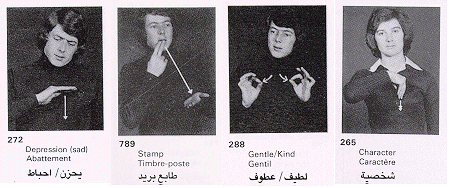| ||||||||||||||
|
Manual EsperantoMost people agree that everybody being able to talk to one another would be a good thing. Everybody also agrees that artificial languages like Esperanto are not the answer. Esperanto is earnest, it's high-minded, and it stands no chance of being widely and seriously adopted. (By which I mean with man-on-the-street kind of wide adoption. Esperanto does have a substantial worldwide community of enthusiasts.) Any international language can't help being closely related to some languages. In fact, Esperanto is like Spanish, which means speakers of non-Latin languages are at a disadvantage when learning its vocabulary, grammar and pronunciation.
But signed languages are, to me at least, easier to learn. You can learn to count to ten in 10 seconds in sign - try that with French or Greek or Swahili or Cantonese. The word for dance is to show two little legs dancing on a dancefloor - much more transparent and memorable than a random string of sounds. And pronunciation is much easier too - there are no tones, no unfamiliar vowel sounds, no difficult consonant clusters, no residual accent from your own language. But the bad news is that there is no widely used International Sign Language. Even American and British sign languages are different. The intercommunicative power of sign languages are, by historical bad luck, even less than spoken languages. ! There is a candidate international sign language, called Gestuno. It, like Esperanto, is earnest, high-minded, and not really practical. How lovely if it could be. One problem with Gestuno is its marketing: it comes across as geeky, wonkish and not really human-scale. Check out the signs above from a Gestuno book. Not very appealing either. But if some population of people, and I mean hearing people, not just Deaf, start using a sign system to talk to each other, such as in Europe where there are lots of languages nearby to each other, or in any kind of international scene, then that's the ideal. If we had a real, living, cross-linguistic sign system, it could be a real international language, with all the advantages of a signed system, and so few barriers to adoption. Thumbs up if that ever happens!
| |||||||||||||
